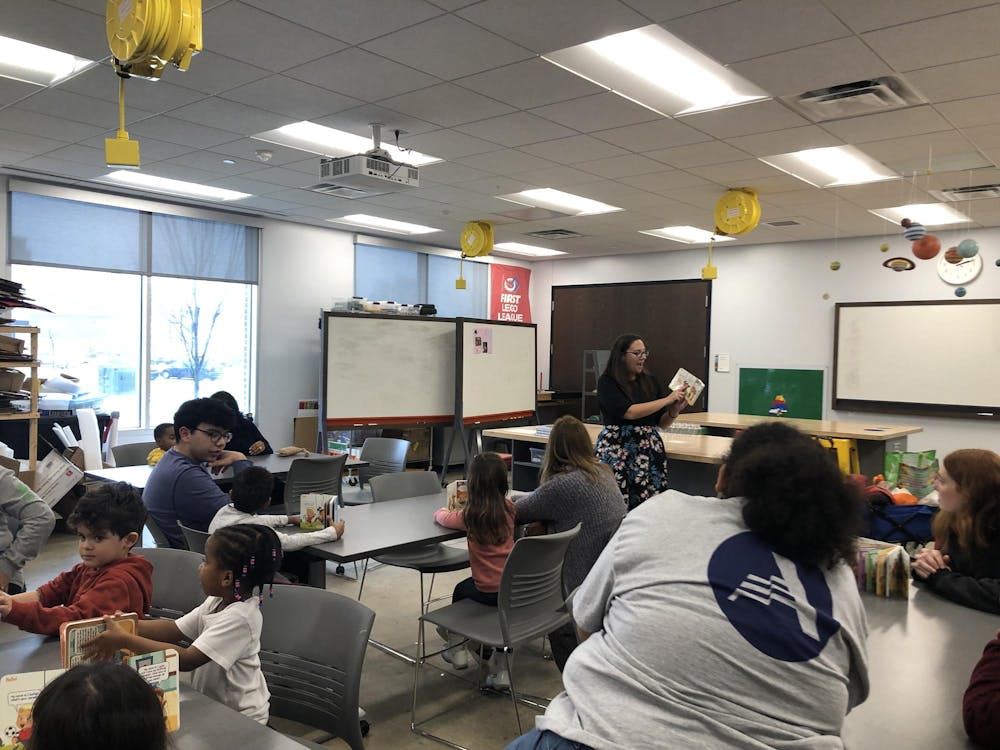On Friday, Saint Mary’s College alumna Stephanie Ryan gave a reading of her children's book, “Let’s Learn About Chemistry,” at the Robinson Community Learning Center.
Ryan's “passion project” was inspired by several parts of her life.
“I had my son, and I am a curriculum developer, and I started to think of misconceptions people have about chemistry. I’m just writing and I’m thinking, you know a lot of basic chemistry is actually just solids, liquids and gasses … and I thought, you know we could actually do this a lot earlier,” Ryan said.
The book began as a PowerPoint slideshow, and once Ryan realized its potential she began a Kickstarter campaign to launch the book. She said that the Saint Mary’s and Notre Dame communities “really helped get it off the ground.”
As the project gained momentum Ryan sent illustrations out to the community who helped fund the book to get a sense of which style worked best. Then, Ryan reached out to the illustrator Christine Cagara who helped bring her artistic vision to life.
Ryan said her husband, who is not a chemist, read over the book in its early stages and felt that it “talked down” to the reader. So, Ryan hired a developmental editor because “because sometimes talking to kids is not as easy as you’d think it is,” Ryan said.
Ryan said, “[My developmental editor] was the one who suggested putting the words underneath with the answers in it so that the parent, who might not be a scientist, would know [which is] the solid, the liquid and the gas so that they don’t have to feel like they don’t know the answer.”
“Let's Learn About Chemistry” is formatted with series of four images and the young reader picks which of the four does not belong in the category. On the opposite page, Ryan explains how the states of matter affect each answer.
Throughout the book, Ryan includes four young characters the reader can follow along with. These characters appeal to the target audience of the book, children ages 0 to 6.
Nearing the end of the creation process, Ryan hired a copy editor and a publicist and then ran into the COVID-19 pandemic.The lockdown meant that Ryan was unable to go to book launches or read at bookshops or preschools. So, she began sharing her work through social media.
She created the series “Let’s Learn About Science” on social media where she demonstrated simple experiments using household objects that parents could use to teach their children about science.
During her visit to the Robinson Community Learning Center, Ryan led the class of preschoolers and their families in one of these experiments, creating lava lamps out of water, vegetable oil and food coloring.
“Science is fun … I really hope that the parents took away that everything that we just did they can do in their kitchen at home, and that they don’t need to be scientists to do it, and that they can just do it on a random Thursday evening for fun,” Ryan said.
She continued, “I think that STEM is all around us. It is life. STEM is a tool that helps explain the world around us, so I think that it’s not really a ‘get involved in’, it’s to help them explain what’s going on around them.”
Ryan commented on her time at Saint Mary’s, explaining how she had a professor during her work-study period who pulled her aside and asked if she had ever considered teaching.
“My junior year, everybody sat down and they worked out a way to make it so that I could get what I needed to leave with education as a secondary [major], and then I went into graduate school with that focus … Saint Mary’s was instrumental in helping me even find that that was a spark I had,” Ryan said.
Looking to the future, Ryan said she has another book in the works about oxygen, and readers can learn more about her work and upcoming book on Instagram and TikTok @letslearnaboutscience.










